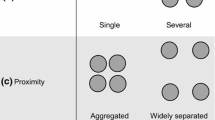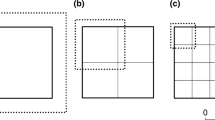Abstract
This chapter examines the idea of habitat networks and how these relate to conservation. First, I explore the concepts behind the idea of habitat networks, particularly the need for placing reserves in a landscape context, the importance of connectivity, and the elements making up networks. Then I discuss examples of planning for, and implementation of, habitat networks, and I point out that although the network concept is well-established in a planning context, actual on-ground applications are still sparse. I then develop a set of principles for applying landscape ecology in the context of reserve networks and discuss gaps in our knowledge that hamper this application. I end with recommendations for an integrated research approach to redress these gaps.
Access this chapter
Tax calculation will be finalised at checkout
Purchases are for personal use only
Preview
Unable to display preview. Download preview PDF.
Similar content being viewed by others
References
Ahern, J. 1995. Greenways as a planning strategy. Landsc. Urban Plan. 33:131–155.
Arts, G.H.P., van Buuren, M., Jongman, R.H.G., Nowicki, P., Wascher, D., and Hoek, I.H.S., eds. 1995a. Landschap-Special Issue on Ecological Networks 12(3).
Arts, G.H.P., van Buuren, M., Jongman, R.H.G., Nowicki, P., Wascher, D., and Hoek, I.H.S. 1995b. Editorial. Landschap 12:5–9.
Barrett, G., and Davidson, I. 2000. Community monitoring of woodland habitats-the Birds on Farms Survey. In Temperate Eucalypt Woodlands in Australia: Biology, Conservation, Management and Restoration, eds. R.J. Hobbs and C.J. Yates, pp. 382–399. Chipping Norton, Australia: Surrey Beatty and Sons.
Bennett, A.F. 1999. Linkages in the Landscape: The Role of Corridors and Connectivity in Wildlife Conservation. Gland, Switzerland and Cambridge, United Kingdom: The World Conservation Union (IUCN) Forest Conservation Programme.
Brooker, L., Brooker, M., and Cale, P. 1999. Animal dispersal in fragmented habitat: measuring habitat connectivity, corridor use, and dispersal mortality. Conserv. Ecol. [online] 3: 4. Available from the Internet: www.consecol.org/vol3/issl/art4.
Burroughs, R.H., and Clark, T.W. 1995. Ecosystem management: a comparison of Greater Yellowstone and Georges Bank. Environ. Manage. 19:649–663.
Cale, P., and Hobbs, R.J. 1994. Landscape heterogeneity indices: problems of scale and applicability, with particular reference to animal habitat description. Pac. Conserv. Biol. 1:183–193.
Dasmann, R.F. 1988. Biosphere reserves, buffers and boundaries. BioScience 38:487–489.
Fabos, J.G. 1995. Introduction and overview: the greenway movement, uses and potentials of greenways. Landsc. Urban. Plan. 33:1–13.
Forman, R.T.T. 1995. Land Mosiacs: The Ecology of Landscapes and Regions. Cambridge, United Kingdom: Cambridge University Press.
Frohn, R.C. 1997. Remote Sensing for Landscape Ecology: New Metrics for Monitoring, Modeling and Assessment of Ecosystems. Boca Raton, Florida: Lewis.
Hanski, I.A., and Gilpin, M.E., eds. 1997. Metapopulation Biology: Ecology, Genetics, and Evolution. New York: Academic Press.
Hanski, I., and Simberloff, D. 1997. The metapopulation approach, its history, conceptual domain, and application to conservation. In Metapopulation Biology: Ecology, Genetics, and Evolution, eds. I.A. Hanski and M.E. Gilpin, pp. 5–26. New York: Academic Press.
Hargis, CD., Bissonette, J.A., and David, J.L. 1998. The behavior of landscape metrics commonly used in the study of habitat fragmentation. Landsc. Ecol 13:167–186.
Harris, L.D. 1984. The Fragmented Forest: Island Biogeographic Theory and the Preservation of Biotic Diversity. Chicago: University of Chicago Press.
Harrison, S., and Fahrig, L. 1995. Landscape pattern and population conservation. In Mosaic Landscapes and Ecological Processes, eds. L. Hansson, L. Fahrig, and G. Merriam, pp. 293–307. London: Chapman and Hall.
Harwell, M.A., Long, J.F., Bartuska, A.M., Gentile, J.H., Harwell, C.C., Myers, V., and Ogden, J.C. 1996. Ecosystem management to achieve ecological sustainability: the case of South Florida. Environ. Manage. 20:497–521.
Hay, K.G. 1991. Greenways and biodiversity. In Landscape Linkages and Biodiversity, ed. W.E. Hudson, pp. 162–175. Washington, DC: Island Press.
Henle, K. 1995. Biodiversity, people and a set of important connected questions. In Nature Conservation 4: The Role of Networks, eds. D.A. Saunders, J.L. Craig, and E.M. Mattiske, pp. 162–174. Chipping Norton, Australia: Surrey Beatty and Sons.
Hobbs, R.J. 1992. Corridors for conservation: solution or bandwagon? Trends Ecol. Evol. 7:389–392.
Hobbs, R.J. 1993a. Effects of landscape fragmentation on ecosystem processes in the Western Australian wheatbelt. Biol Conserv. 64:193–201.
Hobbs, R.J. 1993b. Can revegetation assist in the conservation of biodiversity in agricultural areas? Pac. Conserv. Biol. 1:29–38.
Hobbs, R.J. 1994. Fragmentation in the wheatbelt of Western Australia: landscape scale problems and solutions. In Fragmentation in Agricultural Landscapes, ed. J. Dover, pp. 3–20. Garstang, United Kingdom: International Association for Landscape Ecology.
Hobbs, R.J. 1998. Managing ecological systems and processes. In Ecological Scale: Theory and Applications, eds. D. Peterson and V.T. Parker, pp. 459–484. New York: Columbia University Press.
Hobbs, R.J., Saunders, D.A., and Arnold, G.W 1993a. Integrated landscape ecology: a Western Australian perspective. Biol. Conserv. 64:231–238.
Hobbs, R.J., Saunders, D.A., Lobry de Bruyn, L.A., and Main, A.R. 1993b. Changes in biota.In Reintegrating Fragmented Landscapes: Towards Sustainable Production and Nature Conservation, eds. R.J. Hobbs and D.A. Saunders, pp. 65–106. New York: Springer-Verlag.
Hobbs, R.J., and Wilson, A.-M. 1998. Corridors: theory, practice and the achievement of conservation objectives. In Key Concepts in Landscape Ecology, eds. J.W. Dover and R.G.H. Bunce, pp. 265–279. Preston, United Kingdom: International Association for Landscape Ecology.
Jedicke, E. 1994. Biotopverbund: Grundlagen und Massnahmen einer neuen Na-tureschutzstrategie. Stuttgart, Germany: Ulmer.
Jongman, R.H.G. 1995. Nature conservation planning in Europe: developing ecological networks. Landsc. Urban Plan. 32:169–183.
Kolasa, J., and Waltho, N. 1998. A hierarchical view of habitat and its relationship to species abundance. In Ecological Scale: Theory and Applications, eds. D. Peterson and V.T. Parker, pp. 55–76. New York: Columbia University Press.
Lambeck, R.J. 1997. Focal species: a multi-species umbrella for nature conservation. Consent. Biol. 11:849–856.
Laurance, W.F., and Bierregaard, R.O., eds. 1997. Tropical Forest Remnants: Ecology, Conservation and Management of Fragmented Communities. Chicago: University of Chicago Press.
Linehan, J., Gross, M., and Finn, J. 1995. Greenway planning: developing a landscape ecological network approach. Landsc. Urban Plan. 33:179–193.
Little, C.E. 1990. Greenway s for America. Baltimore, Maryland: The Johns Hopkins University Press.
McCulloch, D.R., ed. 1996. Metapopulations and Wildlife Conservation. Washington, DC: Island Press.
McIntyre, S., and Hobbs, R. 1999. A framework for conceptualizing human effects on landscapes and its relevance to management and research models. Conserv. Biol. 13:1282–1292.
McIntyre, S., and Hobbs, R.J. 2001. Human impacts on landscapes: matrix condition and management priorities. In Nature Conservation 5: Nature Conservation in Production Environments, eds. J. Craig, D.A. Saunders, and N. Mitchell, pp. 301–307. Chipping Norton, Australia: Surrey Beatty and Sons.
Morton, S.R., Stafford Smith, D.M., Friedel, M.H., Griffin, G.F., and Pickup, G. 1995. The stewardship of arid Australia: ecology and landscape management. J. Environ. Manage. 43:195–217.
Noss, R.F. 1992. The Wildlands Project land conservation strategy. Wild Earth, Special Issue: 10–25.
Noss, R.F, and Cooperrider, A.Y. 1994. Saving Nature’s Legacy: Protecting and Restoring Biodiversity. Washington, DC: Island Press.
Noss, R.F, and Harris, L.D. 1986. Nodes, networks and MUMs: preserving diversity at all scales. Environ. Manage. 10:299–309.
Opdam, P., Foppen, R., Reijnen, R., and Schotman, A. 1994. The landscape ecological approach in bird conservation: integrating the metapopulation concept into spatial planning. Ibis 137:S139–S146.
Pearson, S.M., Turner, M.G., Gardner, R.H., and O’Neill, R.V. 1996. An organism-based perspective of habitat fragmentation. In Biodiversity in Managed Landscapes: Theory and Practice, eds. R.C. Szaro and D.W. Johnston, pp. 77–95. New York: Oxford University Press.
Povilitis, T. 1993. Applying the biosphere reserve concept to a greater ecosystem: the San Juan Mountain area of Colorado, New Mexico. Nat. Areas J. 13:18–28.
Ryan, P. 2000. The use of revegetated areas by vertebrate fauna in Australia: a review. In Temperate Eucalypt Woodlands in Australia: Biology, Conservation, Management and Restoration, eds. R.J. Hobbs and C.J. Yates, pp. 318–335. Chipping Norton, Australia: Surrey Beatty and Sons.
Saunders, D.A., Hobbs, R.J., and Margules, CR. 1991. Biological consequences of ecosystem fragmentation: a review. Conserv. Biol. 5:18–32.
Saunders, D.A., and Ingram, J. 1995. Birds of Southwestern Australia: An Atlas of Changes in the Distribution and Abundance of the Wheatbelt Fauna. Chipping Norton, Australia: Surrey Beatty and Sons.
Schwartz, M.W, ed. 1997. Conservation in Highly Fragmented Landscapes. New York: Chapman and Hall.
Simberloff, D. 1998. Flagships, umbrellas, and keystones: is single species management passé in the landscape era? Biol. Conserv. 83:247–257.
Smith, D.S., and Hellmund, P.C., eds. 1993. Ecology of Greenways: Design and Function of Linear Conservation Areas. Minneapolis: University of Minnesota Press.
Soulé, M.E. 1995. An unflinching vision: networks of people defending networks of lands. In Nature Conservation 4: The Role of Networks, eds. D.A. Saunders, J.L. Craig, and E.M. Mattiske, pp. 1–8. Chipping Norton, Australia: Surrey Beatty and Sons.
State of Maryland 1990. Greenways... A Bold Idea For Today, A Promise for Tomorrow. State of Maryland: Department of Natural Resources.
Taylor, P.D., Fahrig, L., Henein, K., and Merriam, G. 1993. Connectivity as a vital element of landscape structure. Oikos 68:571–573.
Therres, G.D., McKegg, J.S., and Miller, R.L. 1988. Maryland’s Chesapeake Bay Critical Area Program: implications for wildlife. Trans. N. Am. Wildl. Nat. Resour. Conf. 53:391–400.
Trani, M.K., and Giles, R.H. 1999. An analysis of deforestation: metrics used to describe pattern change. For. Ecol. Manage. 114:459–470.
UNESCO. 1974. Task Force on Criteria and Guidelines for the Choice and Establishment of Biosphere Reserves. Man and the Biosphere Report Number 22. Paris: United Nations Educational, Scientific, and Cultural Organization.
Vitousek, P.M., Mooney, H.A., Lubchenco, J., and Melillo, J. 1997. Human domination of Earth’s ecosystems. Science 277:494–499.
Watson, J., Lullfitz, W., Sanders, A., and McQuoid, N. 1995. Networks and the Fitzgerald River National Park Biosphere Reserve, Western Australia. In Nature Conservation 4: The Role of Networks, eds. D.A. Saunders, J.L. Craig, and E.M. Mattiske, pp. 482–487. Chipping Norton, Australia: Surrey Beatty and Sons.
Wiens, J.A. 1996. Wildlife in patchy environments: metapopulations, mosaics, and management. In Metapopulations and Wildlife Conservation, ed. D.R. McCulloch, pp. 53–84. Washington, DC: Island Press.
Wiens, J.A. 1997. Metapopulation dynamics and landscape ecology. In Metapopulation Biology: Ecology, Genetics, and Evolution, eds. I.A. Hanski and M.E. Gilpin, pp. 43–62. New York: Academic Press.
With, K.A. 1997. The application of neutral landscape models in conservation biology. Conserv. Biol. 11:1069–1080.
With, K.A., and Crist, TO. 1995. Critical thresholds in species’ responses to landscape structure. Ecology 76:2446–2459.
Editor information
Editors and Affiliations
Rights and permissions
Copyright information
© 2002 Springer Science+Business Media New York
About this chapter
Cite this chapter
Hobbs, R.J. (2002). Habitat Networks and Biological Conservation. In: Gutzwiller, K.J. (eds) Applying Landscape Ecology in Biological Conservation. Springer, New York, NY. https://doi.org/10.1007/978-1-4613-0059-5_9
Download citation
DOI: https://doi.org/10.1007/978-1-4613-0059-5_9
Publisher Name: Springer, New York, NY
Print ISBN: 978-0-387-95322-9
Online ISBN: 978-1-4613-0059-5
eBook Packages: Springer Book Archive




